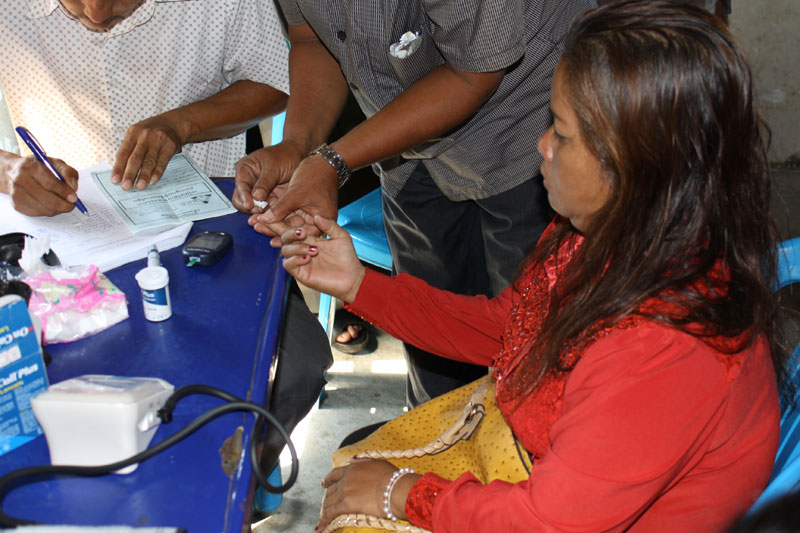Every week, dozens of diabetics gather at a home in the Boeng Kak lake neighborhood to have their weight, blood sugar levels and blood pressure checked.
They are among 12,000 impoverished people across the country taking part in the NGO MoPoTsyo’s peer support program, which allows them to self-manage their diabetes at a fraction of the cost of visiting a doctor.

A further 600,000 people have been screened for the disease by peer educators such as Meach Lina, a diabetic who runs the weekly meetings and refers patients who require treatment to a doctor who receives subsidies from the NGO.
“Before they come to us, they do not know how to take care of their health,” she said. “We teach them how to manage their food and exercise and how to use the medication.”
Non-communicable diseases such as diabetes accounted for 46 percent of deaths in Cambodia in 2008, according to the most recent data from the World Health Organization.
But in a country whose struggling health system is often geared to dealing with acute conditions, and where donor funds are often funneled to treatment of communicable diseases such as HIV and malaria, help for diabetes patients is limited.
According to the International Diabetes Federation, diabetes affected 221,430 people in Cambodia last year, of whom 5,540 died as a result of the condition. An estimated 140,000 cases went undiagnosed.
But despite the desperate need, MoPoTsyo’s director Maurits van Pelt said the service—which began in Boeng Kak in 2005—is now at serious risk of being shut down, after its funding dried up.
Until now, international donors including the World Diabetes Foundation and German aid agency GIZ have helped to expand the service to rural areas in provinces such as Takeo, Kompong Speu and Kompong Thom.
But when the peer education structure was officially adopted in the Ministry of Health’s National Strategic Plan for the Prevention and Control of Noncommunicable Diseases for 2013 to 2020, Mr. van Pelt believed that the government would take over the program.
Instead, the ministry failed to release either the 2013 or 2014 funds to operational health districts. And with donors having taken a step back from funding to allow the government to take over, the program is now in a dangerous limbo.
Unless the Ministry of Health or a donor steps in by June 30, Mr. van Pelt said, MoPoTsyo would no longer be able to pay its bills.
“It is, or should be, a public service. But who is going to provide the public service? The government has got to assume a role,” he said.
Attempts to contact multiple Ministry of Health officials for comment were unsuccessful.
To make ends meet, MoPoTsyo has scaled back its operations, moving to a small office in Phnom Penh’s Meanchey district and laying off 13 staff members. There is evidence that in at least one rural area, a lack of funds is already beginning to bite.
Nourn Sophat, director of the Prey Kabbas district referral hospital in Takeo province, said the hospital, which treats patients sent from the peer support network, had not received any money from the NGO for nine months.
“They provided medicines at an affordable price for poor people,” he said. “It helped to reduce poverty in our district since people do not need to go to private clinics or spend money on transportation.”
Mr. Sophat said he would like to see the program expanded in the area. That seems unlikely for now.
MoPoTsyo is not the only diabetes organization struggling to make ends meet.
Cambodian Diabetes Association president Lim Keuky said while his organization had also established a peer network, in Siem Reap province, it reached just 600 people, with plans to reach 1,000 by year’s end.
“We have no means to provide consultations and medication to people suffering diabetes in rural areas because there are no means to pay for the medication,” he said.
But health experts, including the authors of the Ministry of Health’s strategic plan, agree that increasing urbanization, more-sedentary lifestyles and poor dietary habits mean the problem is not going away.
“People eat too much white rice, far too much white rice, and not enough vegetable and proteins. They are much less active now, but still eating white rice like they’re building Angkor Wat,” Mr. van Pelt said.
Rose Nith, 75, who attends the weekly sessions at Ms. Lina’s home to get help managing his high blood pressure, urged the government and donors to support the peer education program.
“Without this center our community will be in difficulty, since we rely on this center and it supports us…. Some people will die since they cannot afford to buy medicine without it,” she said.
“When you have money, you still have some hope, but when you run out of money, your life is shorter. Today, everything is about money. When we go to the hospital we have to have the money in our hands, because without money, the doctors will let you die,” Ms. Nith said.



